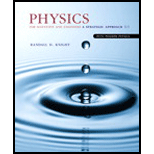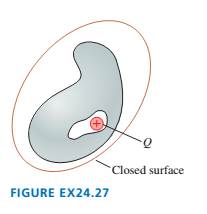
Physics for Scientists and Engineers: A Strategic Approach with Modern Physics (4th Edition)
4th Edition
ISBN: 9780133942651
Author: Randall D. Knight (Professor Emeritus)
Publisher: PEARSON
expand_more
expand_more
format_list_bulleted
Concept explainers
Textbook Question
Chapter 24, Problem 27EAP
FIGURE EX24.27 shows a hollow cavity within a neutral conduc-
tor. A point charge Q is inside the cavity. What is the net electric flux
through the closed surface that surrounds the conductor?

Expert Solution & Answer
Learn your wayIncludes step-by-step video

schedule01:58
Students have asked these similar questions
Please solve and answer the question correctly please. Thank you!!
Please solve and answer the question correctly please. Thank you!!
Please view both photos, and answer the question correctly please. Thank you!!
Chapter 24 Solutions
Physics for Scientists and Engineers: A Strategic Approach with Modern Physics (4th Edition)
Ch. 24 - Suppose you have the uniformly charged cube in...Ch. 24 - FIGURE Q24.2 shows cross sections of...Ch. 24 - The square and circle in FIGURE Q24.3 are in the...Ch. 24 - Prob. 4CQCh. 24 - Prob. 5CQCh. 24 - What is the electric flux through each of the...Ch. 24 - Prob. 7CQCh. 24 - The two spheres in FIGURE Q24.8 on the next page...Ch. 24 - The sphere and ellipsoid in FIGURE Q24.9 surround...Ch. 24 - A small, metal sphere hangs by an insulating...
Ch. 24 - l. FIGURE EX24.1 shows two cross sections of two...Ch. 24 - FIGURE EX24.2 shows a cross section of two...Ch. 24 - FIGURE EX24.3 shows a cross section of two...Ch. 24 - The electric field is constant over each face of...Ch. 24 - The electric field is constant over each face of...Ch. 24 - The cube in FIGURE EX24.6 contains negative...Ch. 24 - The cube in FIGURE EX24.7 contains negative...Ch. 24 - The cube in FIGURE EX24.8 contains no net charge....Ch. 24 - What is the electric flux through the surface...Ch. 24 - What is the electric flux through the surface...Ch. 24 - II The electric flux through the surface shown in...Ch. 24 - ]12. A 2.0cm3.0cm rectangle lies in the xy-plane....Ch. 24 - A 2.0cm3.0cm rectangle lies in the xz-plane. What...Ch. 24 - Prob. 14EAPCh. 24 - 15. A box with its edges aligned with
the...Ch. 24 - What is the net electric flux through the two...Ch. 24 - FIGURE EX24.17 shows three charges. Draw these...Ch. 24 - Prob. 18EAPCh. 24 - FIGURE EX24.19 shows three Gaussian surfaces and...Ch. 24 - What is the net electric flux through the torus...Ch. 24 - What is the net electric flux through the cylinder...Ch. 24 - Prob. 22EAPCh. 24 - Prob. 23EAPCh. 24 - A spark occurs at the tip of a metal needle if the...Ch. 24 - The electric field strength just above one face of...Ch. 24 - The conducting box in FIGURE EX24.26 has been...Ch. 24 - FIGURE EX24.27 shows a hollow cavity within a...Ch. 24 - A thin, horizontal, 10-cm-diameter copper plate is...Ch. 24 - Prob. 29EAPCh. 24 - Prob. 30EAPCh. 24 - II A tetrahedron has an equilateral triangle base...Ch. 24 - Charges q1= —4Q and q2= +2Q are located at x = —a...Ch. 24 - Prob. 33EAPCh. 24 - A spherically symmetric charge distribution...Ch. 24 - A neutral conductor contains a hollow cavity in...Ch. 24 - Prob. 36EAPCh. 24 - 37. A 20-cm-radius ball is uniformly charged to 80...Ch. 24 - Prob. 38EAPCh. 24 - Prob. 39EAPCh. 24 - Prob. 40EAPCh. 24 - A hollow metal sphere has 6 cm and 10 cm inner and...Ch. 24 - Prob. 42EAPCh. 24 - Find the electric field inside and outside a...Ch. 24 - Prob. 44EAPCh. 24 - Prob. 45EAPCh. 24 - Prob. 46EAPCh. 24 - FIGURE P24.47 shows an infinitely wide conductor...Ch. 24 - FIGURE P24.48 shows two very large slabs of metal...Ch. 24 - Prob. 49EAPCh. 24 - A very long, uniformly charged cylinder has radius...Ch. 24 - Prob. 51EAPCh. 24 - Prob. 52EAPCh. 24 - II A long cylinder with radius b and volume charge...Ch. 24 - A spherical shell has inner radius Rin, and outer...Ch. 24 - Prob. 55EAPCh. 24 - Newton's law of gravity and Coulomb's law are both...Ch. 24 - Prob. 57EAPCh. 24 - An infinite cylinder of radius R has a linear...Ch. 24 - Prob. 59EAPCh. 24 - A sphere of radius R has total charge Q. The...Ch. 24 - II A spherical ball of charge has radius R and...
Additional Science Textbook Solutions
Find more solutions based on key concepts
Explain why hyperthermophiles do not cause disease in humans.
Microbiology with Diseases by Body System (5th Edition)
APPLY 1.2 Express the following quantities in scientific notation
using fundamental SI units of mass and lengt...
Chemistry (7th Edition)
Does the graph you constructed support or refute the concept of a weak asthenosphere that is capable of ' flowi...
Applications and Investigations in Earth Science (9th Edition)
Match each of the following items with all the terms it applies to:
Human Physiology: An Integrated Approach (8th Edition)
Which of the following factors would tend to increase membrane fluidity? A. a greater proportion of unsaturated...
Campbell Biology in Focus (2nd Edition)
What global policy changes and what individual choices can help us sustain the planet that sustains us?
Biology: Life on Earth with Physiology (11th Edition)
Knowledge Booster
Learn more about
Need a deep-dive on the concept behind this application? Look no further. Learn more about this topic, physics and related others by exploring similar questions and additional content below.Similar questions
- A thrown brick hits a window, but doesn't break it. Instead it reverses direction and ends down on the ground below the window. Since the brick didn't break the glass, we know: О The force of the brick on the glass > the force of the glass on the brick. О The force of the brick on the glass the force of the glass on the brick. = О The force of the brick on the glass < the force of the glass on the brick. О The brick didn't slow down as it broke the glass.arrow_forwardAlexandra (wearing rubber boots for traction) is attempting to drag her 32.6-kg Golden Retriever across the smooth ice by applying a horizontal force. What force must she apply to move the dog with a constant speed of 0.950 m/s? ☐ 31.0 lb. ☐ 319 kg. ○ Zero. 32.6 kg.arrow_forwardThe figure shows a graph of the acceleration of an object as a function of the net force acting on it. The mass of this object, in grams, is closest to 11 a(m/s²) 8.0+ 6.0- 4.0- 2.0- 0+ F(N) 0.00 0.50 1.00 ☐ 130 ○ 8000 ☐ 89arrow_forward
- Values that are within standard deviations represent measurements that are considered to be near the true value. Review the data from the lab and determine whether your data is within standard deviations. Report, using numerical values, whether your data for each angle is within standard deviations. An acceptable margin of error typically falls between 4% and 8% at the 95% confidence level. Review your data for each angle to determine whether the margin of error is within an acceptable range. Report with numerical values, whether your data for each angle is within an acceptable margin of error. Can you help explain what my data means in terms of the standard deviation and the ME? Thanks!arrow_forwardA sinusoidal wave is propagating along a stretched string that lies along the x-axis. The displacement of the string as a function of time is graphed in (Figure 1) for particles at x = 0 and at x = 0.0900 m. You are told that the two points x = 0 and x = 0.0900 m are within one wavelength of each other. If the wave is moving in the +x-direction, determine the wavelength. If instead the wave is moving in the -x-direction, determine the wavelength. Please show all stepsarrow_forwardYou are designing a two-string instrument with metal strings 35.0 cm long, as shown in (Figure 1). Both strings are under the same tension. String S1 has a mass of 8.30 g and produces the note middle C (frequency 262 Hz ) in its fundamental mode. What should be the tension in the string? What should be the mass of string S2 so that it will produce A-sharp (frequency 466 Hz ) as its fundamental? To extend the range of your instrument, you include a fret located just under the strings but not normally touching them. How far from the upper end should you put this fret so that when you press S1 tightly against it, this string will produce C-sharp (frequency 277 Hz ) in its fundamental? That is, what is x in the figure? If you press S2 against the fret, what frequency of sound will it produce in its fundamental?arrow_forward
- Please solve and answer the problem correctly please. Thank you!!arrow_forwardPlease help explain this. The experiment without the sandpaper had a 5% experimental error, with sandpaper it is 9.4%. Would the explaination be similar to the experiment without sandpaper? Thanks!arrow_forwardA sinusoidal wave with wavelength 0.400 m travels along a string. The maximum transverse speed of a point on the string is 3.00 m/s and the maximum transverse acceleration is 8.10×104m/s2. What is the propagation speed v of the wave? What is the amplitude A of the wave?arrow_forward
arrow_back_ios
SEE MORE QUESTIONS
arrow_forward_ios
Recommended textbooks for you

 Principles of Physics: A Calculus-Based TextPhysicsISBN:9781133104261Author:Raymond A. Serway, John W. JewettPublisher:Cengage Learning
Principles of Physics: A Calculus-Based TextPhysicsISBN:9781133104261Author:Raymond A. Serway, John W. JewettPublisher:Cengage Learning Physics for Scientists and Engineers: Foundations...PhysicsISBN:9781133939146Author:Katz, Debora M.Publisher:Cengage Learning
Physics for Scientists and Engineers: Foundations...PhysicsISBN:9781133939146Author:Katz, Debora M.Publisher:Cengage Learning College PhysicsPhysicsISBN:9781305952300Author:Raymond A. Serway, Chris VuillePublisher:Cengage Learning
College PhysicsPhysicsISBN:9781305952300Author:Raymond A. Serway, Chris VuillePublisher:Cengage Learning Physics for Scientists and Engineers with Modern ...PhysicsISBN:9781337553292Author:Raymond A. Serway, John W. JewettPublisher:Cengage Learning
Physics for Scientists and Engineers with Modern ...PhysicsISBN:9781337553292Author:Raymond A. Serway, John W. JewettPublisher:Cengage Learning Physics for Scientists and Engineers, Technology ...PhysicsISBN:9781305116399Author:Raymond A. Serway, John W. JewettPublisher:Cengage Learning
Physics for Scientists and Engineers, Technology ...PhysicsISBN:9781305116399Author:Raymond A. Serway, John W. JewettPublisher:Cengage Learning


Principles of Physics: A Calculus-Based Text
Physics
ISBN:9781133104261
Author:Raymond A. Serway, John W. Jewett
Publisher:Cengage Learning

Physics for Scientists and Engineers: Foundations...
Physics
ISBN:9781133939146
Author:Katz, Debora M.
Publisher:Cengage Learning

College Physics
Physics
ISBN:9781305952300
Author:Raymond A. Serway, Chris Vuille
Publisher:Cengage Learning

Physics for Scientists and Engineers with Modern ...
Physics
ISBN:9781337553292
Author:Raymond A. Serway, John W. Jewett
Publisher:Cengage Learning

Physics for Scientists and Engineers, Technology ...
Physics
ISBN:9781305116399
Author:Raymond A. Serway, John W. Jewett
Publisher:Cengage Learning
Electric Fields: Crash Course Physics #26; Author: CrashCourse;https://www.youtube.com/watch?v=mdulzEfQXDE;License: Standard YouTube License, CC-BY